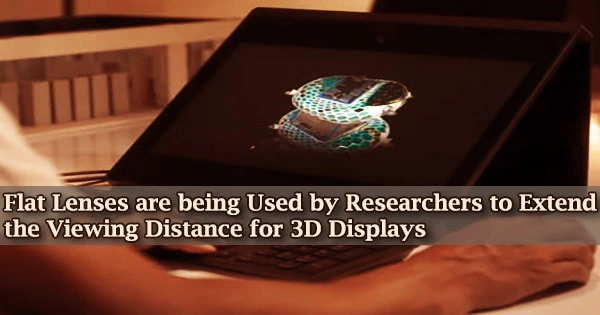Thanks to a newly constructed flat lens, researchers have exhibited a prototype glasses-free 3D light field display system with an increased viewing distance. The technique is a significant step toward creating small, realistic-looking 3D displays for televisions, portable electronics, and table-top devices.
Light field displays produce full-color real-time 3D videos that may be viewed without glasses using a dense field of light beams. This method of constructing a 3D display allows multiple individuals to watch the virtual scene similar to how a genuine 3D item works.
“Most light field 3D displays have a limited viewing range, which causes the 3D virtual image to degrade as the observer moves farther away from the device,” said research team leader Wen Qiao from Soochow University. “The nanostructured flat lens we designed is just 100 microns thick and has a very large depth of focus, which enables a high-quality virtual 3D scene to be seen from farther away.”
The researchers write in Optica, an Optica Publishing Group publication, that their prototype display has good efficiency and color fidelity overviewing distances of 24 cm to 90 cm. All of these features work together to offer a more realistic viewing experience.
“We developed this new technology hoping to create displays that could allow people to feel as if they were actually together during a video conference,” said Qiao. “With the continued development of nanotechnology, we envision that glasses-free 3D displays will become a normal part of everyday life and will change the way people interact with computers.”
Because flat lenses provide superior light manipulating capability compared to traditional glass lenses, they can be used to solve formidable problems such as limited motion parallax, crosstalk, visual fatigue, and limited viewing distances in 3D displays.
Wen Qiao
Creating multiple views
Light field displays produce realistic visuals by projecting many viewpoints that make the 3D scene appear the same from various angles. When it comes to viewing distance, the focal length of the lenses utilized to create these vistas is the limiting factor.
To solve this, the researchers created a novel diffractive flat lens by meticulously arranging nanostructures onto a flat surface in such a way that light is focused. They were able to produce a pixelated view modulator by combining multiple of these lenses, which is the optical component that creates the numerous views for a scene in a light field display.
For example, a 3D display with four views would employ four of these lenses, each of which converges the light into a distinct view.
“Because flat lenses provide superior light manipulating capability compared to traditional glass lenses, they can be used to solve formidable problems such as limited motion parallax, crosstalk, visual fatigue, and limited viewing distances in 3D displays,” said Qiao.
Testing the prototype
The researchers put the lens into a 4-inch prototype 3D light field display with a viewing range between 24 and 90 cm after demonstrating that it achieved great resolution when concentrating the red, green, and blue light utilized by LCDs to create images.
Overall viewing distances, the display formed a smooth horizontal parallax with crosstalk below 26%, indicating that there were few mistakes that would induce eye strain or make the image appear fake.
The display also had a light efficiency of 82 percent, which was significantly higher than that of previous similar 3D display systems that have been reported. For creating a vivid virtual image, high light efficiency is critical, especially in situations where power consumption is a factor, such as portable devices.
The researchers claim that by improving the design of the nanostructures used to manufacture the flat lenses, it may increase the viewing angle of the prototype to nearly 180 degrees.
They also hope to increase light efficiency by developing a more advanced design method for altering the light beam at each pixel in addition to researching it. They point out that for this form of display to be realistic to build, better technologies to fabricate the nanostructures are also required.





